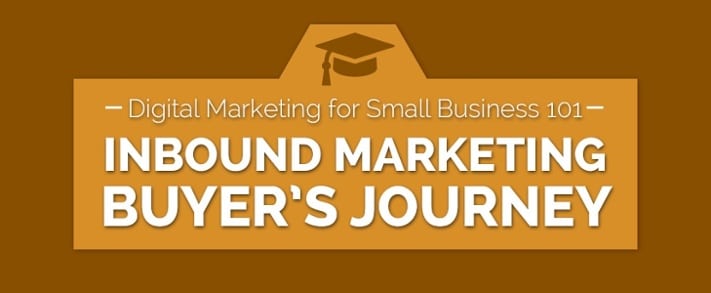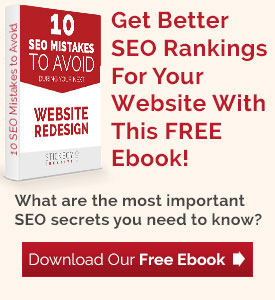29 July 2016
Digital Marketing for Small Business 101: Inbound Marketing Buyer’s Journey
Want to turn your website from a liability to an asset?
Great! We’re going to discuss Digital Marketing for Small Business all week this week – specifically Inbound Marketing, and how it can help your business.

Inbound marketing is a marketing framework that can be summarized as this:
The best way to your ideal customer is by providing the right content at the right time.
To leverage this framework, you’ll need to understand the main three parts of the inbound strategy:
- Ideal Customer, or Buyer Personas
- Quality Content, blog posts, landing pages, Ebooks
- Correct Timing, or The Buyer’s Journey
It’s a powerful framework that is built around how people are shopping for goods and services on the internet. We’ve covered the first part of this method in Part 1, which you can read by clicking here. We’ve also covered Part 2 of Inbound with content marketing, you can read about that by clicking here.
If you haven’t read those yet, I would encourage you to check them now, since this is the post where we bring it all together.
You have a buyer’s persona and you have some content to market to them. But how do you convert this to a lead? How do you make sure that you’re provding the correct content to someone when they’re most ready to hear it? By making sure you understand the Buyer’s Journey.
Interested in more about the buyer’s journey and how it can help focus your business’s marketing? Schedule a FREE 30 minute live demo to find out.
The “Buyer’s Journey” is what your customers go through when researching a purchase online. It exists in 3 stages (with a bonus phase!), which we’ll go in detail below:
Stage 1: Awareness
The Awareness stage is the first stage that your customer is in. They either have just been made aware of your service or they are just starting to check it out. In the previous post, we used scuba diving as an example of how to create targeted content.
Using that example, the “awareness stage” would be you had just started hearing about scuba diving from your friend, and took it upon yourself to find out everything you can about scuba diving for beginners. You look up blog posts about what certifications and equipment you’ll need, what tips to know about, maybe even started checking out ideal dive locations you’d like to see.
What you’re doing is gathering all of the initial information you’ll need so you can make an educated purchase. But how does your customer make an educated purchase?
Stage 2: Consideration
In the next stage, your customer has the basics down and they have applied some of that information to their unique situation. They’re a beginner, so they know the kinds of equipment they’ll need, the locations that are near them, and the certifications they’ll need to get started.
At this point they’re educated and empowered. They’re excited at the idea of scuba diving and they’re more motivated to buy because they have a better understanding of what it is they need. They’ve taken what they’ve learned in Stage 1 and applied it to themselves. With that, they move into the next stage.
Stage 3: Decision
Armed with their research they start to look for solutions and opportunities that are available to them. They seek out the actual companies and businesses that can supply them with the equipment they need and the trips they’d like to take – they’re making purchasing decisions in this stage and are looking for the company can give them the best value for the solution they want.
The more of this process you can control, the better you’re able to position your company’s unique value.
Bonus Stage: Raving Fans
This is the bonus stage. When a customer has purchased your product or service and is so blown away by the quality that they leave a review and encourage others to check you out. This could mean they motivate others to get into the Awareness stage, or because they pass on their own knowledge, their endorsement may send more customers straight into the consideration stage.
But Wait, It’s Not This Easy
You may be thinking it’s trivial to get the customer to move through each stage of the journey, but it isn’t. It can prove to be as hard as herding cats, it seems. What you’ll want to do is not only provide content that speaks to your Buyer’s Persona during each phase of the Buyer’s Journey, but also provide them with offers and incentives to move further through it. Here’s an example outline with our Scuba scenario:
Awareness:
- Video series showing new divers and what scuba diving in South Florida is like
- Moving them to Consideration: An ebook showing all of the best diving locations in South Florida as well as maps and reviews.
Consideration
- Blog post about the 9 pieces of equipment every new diver needs if they’re diving in South Florida
- Moving them to Decision: A 10% off coupon if they purchase any of the items on this list
Decision
- Products arranged in logical categories with reviews and demonstrations allowing your customers to know they’re making the correct purchase
Raving Fans
- Follow up email 10 days after purchase asking if they’re satisfied
The above is an actionable digital marketing plan that uses the principles of Inbound Marketing to educate and motivate your customers. They’ll be more engaged and have a better understanding of what they need, while at the same time being continually exposed to your brand and it’s message.
That’s the big three parts of inbound marketing, but it’s just the tip of the iceberg. The methods and best practices are much larger and much more powerful when you’re able to put inbound marketing into action.
Interested in more about the buyer’s journey and how it can help focus your business’s marketing? Schedule a FREE 30 minute live demo to find out.



